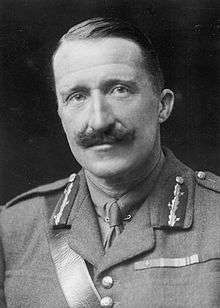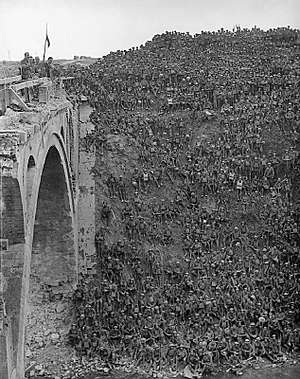John Vaughan Campbell
Brigadier General John Vaughan Campbell, VC, CMG, DSO (31 October 1876 – 21 May 1944) was a senior British Army officer and a recipient of the Victoria Cross, the highest award for gallantry in the face of the enemy that can be awarded to British and Commonwealth forces.
John Vaughan Campbell | |
|---|---|
 Brigadier General John Campbell, c.1917–18 | |
| Born | 31 October 1876 London, England |
| Died | 21 May 1944 (aged 67) Woodchester, Gloucestershire, England |
| Allegiance | United Kingdom |
| Service/ | British Army |
| Years of service | 1896–1933 1939–1944 |
| Rank | Brigadier-General |
| Unit | Coldstream Guards |
| Commands held | 8th Battalion Gloucestershire Home Guard 3rd Battalion, Coldstream Guards |
| Battles/wars | Second Boer War First World War Second World War |
| Awards | Victoria Cross Companion of the Order of St Michael and St George Distinguished Service Order Mentioned in Despatches Officer of the Legion of Honour (France) Croix de guerre (France) |
Early life
Campbell was born in London. His father, second son of the 2nd Earl Cawdor and an army captain, was killed at the Battle of Hlobane in the Zulu War in 1879.
He was educated at Eton College and the Royal Military College, Sandhurst, before entering the Coldstream Guards in 1896.[1] He served through the Second Boer War, in which he was awarded the Distinguished Service Order and twice mentioned in despatches.[1]
First World War
Campbell was 39 years old, and a temporary lieutenant colonel commanding the 3rd Battalion, Coldstream Guards during the First World War when the following deed took place for which he was awarded the VC.
On 15 September 1916 at Ginchy, France, during the Battle of the Somme, Lieutenant Colonel Campbell took personal command of the third line when the first two waves of his battalion had been decimated by machine-gun and rifle fire. He rallied his men and led them against the enemy machine-guns, capturing the guns and killing the personnel. Later in the day he again rallied the survivors of his battalion and led them through very heavy hostile fire. His personal gallantry and initiative at a very critical moment enabled the division to press on and capture objectives of the highest tactical importance.[2]
Not mentioned in the citation but much reported in the popular press, by which he was dubbed the "Tally-Ho VC", is that he rallied his men under fire by blowing a hunting horn and giving the traditional hunting cry.[3]
Later in 1916, he achieved the rank of brigadier general.
Later life

In 1919 he was appointed Aide-de-Camp to King George V, a post held until he retired from the army in 1933, and was subsequently a member of the Honourable Corps of Gentlemen at Arms[1] until his death.
In the Second World War he was an honorary flight lieutenant in the Royal Air Force Volunteer Reserve from 1939 to 1940, then from 1941 until his death commanded the 8th Battalion Gloucestershire Home Guard.[1] He died, aged sixty-seven, at his last home in Woodchester near Stroud, on 21 May 1944, and was cremated at Cheltenham.
His Victoria Cross is displayed at The Guards Regimental Headquarters (Coldstream Guards RHQ) in Wellington Barracks, London.
References
- Kelly's Handbook to the Titled, Landed and Official Classes. 1944. p. 379.
- "No. 29802". The London Gazette (Supplement). 26 October 1916. p. 10393.
- "County heroes who won the Victoria Cross". Shropshire Star. 1 July 2016. p. 36.Battle of the Somme – 100 Years supplement, compiled by Toby Neal. He was then living at Oswestry.